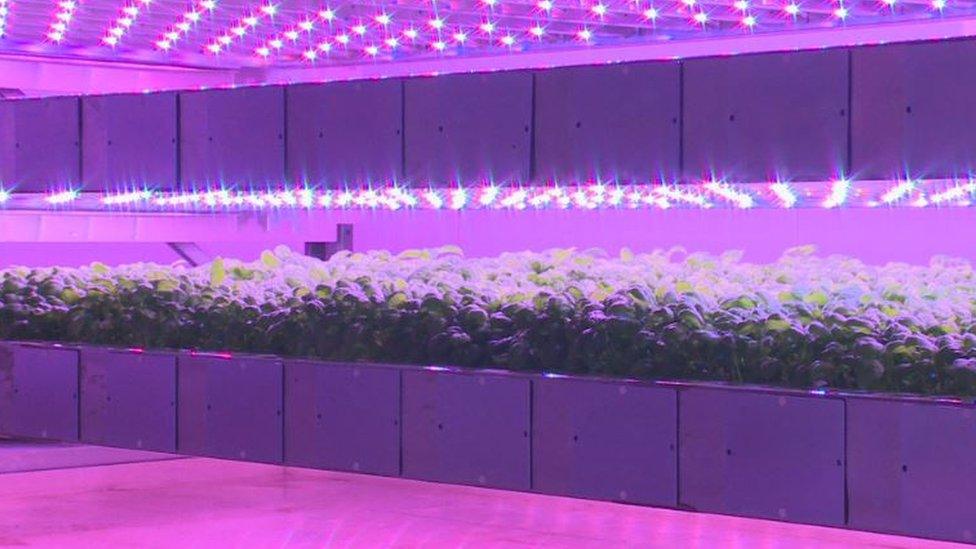Futuristic agriculture at Scotland's first 'vertical' farm
- Published

Basil can be grown in just 20 days in the indoor farm
When you step into the air lock which protects Scotland's first "vertical" farm from the uncontrolled outside world, it feels like you're stepping into the future.
Inside, bright LED lights of differing colours keep the plants illuminated while vents distribute exactly the right flow of air.
The idea is to create the most precise, time-efficient and waste-free method of growing.
Ultimately, this highly mechanised means of producing food could be used in some of the world's most crowded cities.
Literally, the sky is the limit.
The trial centre is housed in a two-storey white building around the back of the James Hutton Institute in Invergowrie, Perth and Kinross.

Bright LED lights keep the plants illuminated while vents distribute air
David Farquhar, chief executive of Intelligent Growth Solutions, told BBC Scotland: "It has the potential to solve a huge range of problems connected to global food security.
"The production of food largely takes place a long way away from the consumption. We've all heard of food miles, we all know there are big issues with water resources around the world and the availability of arable land and a burgeoning population.
"What this has the potential to do is to shorten those supply chains and bring the source of production much closer to the point of consumption. Whether that be in cities or whether it be in deserts.
"That's going to make a very significant difference to the cost of food and the availability of food."
The plant of choice just now is basil, a high-value herb which they can grow in just 20 days.
Researchers have experimented with different colours of light and have managed to reduce the growing time by about half.

The scientists have "absolute control" over light, temperature, humidity, carbon dioxide and irrigation
Because of the short indoor "season", they can test the response of the plants very quickly and then try again.
Plant scientist Matthew Reid said: "In this system we have absolute control over all the environmental parameters. So that's the light, temperature, humidity, the CO2 and the irrigation technique that we use.
"For this trial, all the plants will be given exactly the same treatments apart from the light spectrum that we use.... what we change are the colours of light that the different plants are receiving.
"After the growth cycle we'll destructively harvest the plants to see how the different colours are affecting how the plants are growing."
Vertical farming would result in less reliance on the seasons to determine how and when something is grown.
Because it's expensive to artificially simulate the environment, one of the initial aims is to work out the most cost effective way of producing the crop.

The scientists' work could pave the way for more city centre-based food production
Derek Stewart, from the James Hutton Institute, said: "This is a huge step change for crop and plant production globally.
"It beggars belief, I have to be honest. The advances we are seeing in the ability to control how the crops grow, the speed they grow, the quality that they can manipulate.
"I think the opportunity is there for the farmers to take it if they want. Of course, because it's a closed environment we could see these in city centres.
"There's no limit to where you can put them. Why lock up good agricultural land? That doesn't mean that the farmer can't own it, in the city centre environment."
The scientists say the range of crops which could be produced by this method is limitless.
But economically they say it makes more sense to go for high-value plants.
It has even been suggested it could be used to grow the next generation of cancer drugs or other medicines which come from plants.